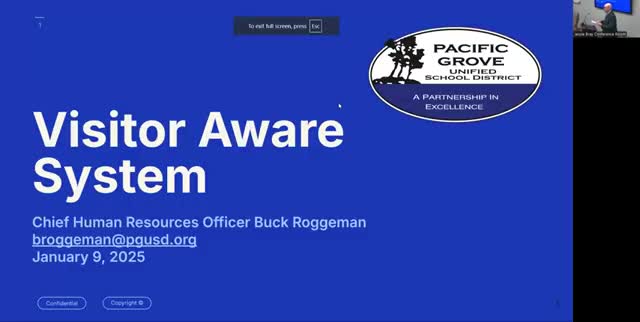Pacific Grove USD rolls out VisitorAware system and fingerprint checks across sites
January 11, 2025 | Pacific Grove Unified, School Districts, California
This article was created by AI summarizing key points discussed. AI makes mistakes, so for full details and context, please refer to the video of the full meeting. Please report any errors so we can fix them. Report an error »

Pacific Grove Unified School District has implemented a district‑wide visitor‑management system to standardize check‑in, improve volunteer fingerprint tracking and provide better visitor accountability during an emergency.
Buck Robeman, chief human resources officer, told the Board that the district installed VisitorAware at seven sites under a three‑year contract. The software cost $13,000 for the sites plus a $1,500 implementation fee, paid from Measure A funds.
How it works and key numbers
Visitors scan a driver’s license, the system captures a photo and prints a sticker. The system compares the ID photo to the new photo at check‑in and requires staff to select the visitor’s destination and purpose. On check‑out a second photo is captured for verification, and staff can view a web roster of who is currently on campus.
Robeman said the system integrates with the district’s fingerprint clearance spreadsheet so office staff can see whether volunteers and chaperones are fingerprinted and cleared. From August through December the district recorded 5,888 check‑ins across sites. Robeman said the district received 0 matches to the Megan’s Law registry among those visitors.
Why the district adopted it
District staff said the system brings consistency across sites, helps account for visitors during an emergency and lets HR and site clerks identify volunteers who still need fingerprint clearance. The HR office is using the daily check‑in logs to reach out to non‑cleared volunteers to schedule fingerprinting.
Board questions and operational points
Trustees asked about facial‑recognition limits, integration with cameras and how the system handles people who do not check out. Robeman and IT staff said VisitorAware uses an internal image‑matching step to compare the ID image and the live photo on check‑in; the system is not designed to integrate with district camera feeds for continuous facial recognition. Staff said they will gather site clerks’ feedback and complete a standard operating procedure (SOP).
Staff also said that some visitors (for example, people attending IEP or 504 meetings) do not require fingerprint clearance but are still asked to check in and receive a visitor badge; if a visitor triggers a Megan’s Law alert they will be accompanied by a certificated staff member for the duration of their visit.
Ending
The board received the update; staff will solicit feedback from site clerks, finalize the SOP and continue using the system to support fingerprint coordination and emergency accounting of visitors.
Buck Robeman, chief human resources officer, told the Board that the district installed VisitorAware at seven sites under a three‑year contract. The software cost $13,000 for the sites plus a $1,500 implementation fee, paid from Measure A funds.
How it works and key numbers
Visitors scan a driver’s license, the system captures a photo and prints a sticker. The system compares the ID photo to the new photo at check‑in and requires staff to select the visitor’s destination and purpose. On check‑out a second photo is captured for verification, and staff can view a web roster of who is currently on campus.
Robeman said the system integrates with the district’s fingerprint clearance spreadsheet so office staff can see whether volunteers and chaperones are fingerprinted and cleared. From August through December the district recorded 5,888 check‑ins across sites. Robeman said the district received 0 matches to the Megan’s Law registry among those visitors.
Why the district adopted it
District staff said the system brings consistency across sites, helps account for visitors during an emergency and lets HR and site clerks identify volunteers who still need fingerprint clearance. The HR office is using the daily check‑in logs to reach out to non‑cleared volunteers to schedule fingerprinting.
Board questions and operational points
Trustees asked about facial‑recognition limits, integration with cameras and how the system handles people who do not check out. Robeman and IT staff said VisitorAware uses an internal image‑matching step to compare the ID image and the live photo on check‑in; the system is not designed to integrate with district camera feeds for continuous facial recognition. Staff said they will gather site clerks’ feedback and complete a standard operating procedure (SOP).
Staff also said that some visitors (for example, people attending IEP or 504 meetings) do not require fingerprint clearance but are still asked to check in and receive a visitor badge; if a visitor triggers a Megan’s Law alert they will be accompanied by a certificated staff member for the duration of their visit.
Ending
The board received the update; staff will solicit feedback from site clerks, finalize the SOP and continue using the system to support fingerprint coordination and emergency accounting of visitors.
Don't Miss a Word: See the Full Meeting!
Go beyond summaries. Unlock every video, transcript, and key insight with a Founder Membership.
✓
Get instant access to full meeting videos
✓
Search and clip any phrase from complete transcripts
✓
Receive AI-powered summaries & custom alerts
✓
Enjoy lifetime, unrestricted access to government data
30-day money-back guarantee

